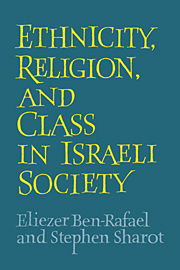Book contents
- Frontmatter
- Contents
- Acknowledgments
- I Theoretical and empirical background
- II Social patterns and behavior
- III Identities and images
- IV The impact of stratification
- V Social cleavages: an overview of Israeli society and some theoretical implications
- Appendix A The sample
- Appendix B Deprivation index
- Appendix C Indexes of ethnic identification
- Glossary
- Notes
- References
- Index
Appendix C - Indexes of ethnic identification
Published online by Cambridge University Press: 12 September 2009
- Frontmatter
- Contents
- Acknowledgments
- I Theoretical and empirical background
- II Social patterns and behavior
- III Identities and images
- IV The impact of stratification
- V Social cleavages: an overview of Israeli society and some theoretical implications
- Appendix A The sample
- Appendix B Deprivation index
- Appendix C Indexes of ethnic identification
- Glossary
- Notes
- References
- Index
Summary
The specific ethnic identification index was constructed by combining the following three measures:
Respondents who placed the specific ethnic identification above the broad ethnic identification in the hierarchy received “1,” the others “0.”
Respondents who expressed a high level of pride in the specific identification (points five and six on the six-point scale) received “1,” the others “0.”
Respondents who expressed a higher level of pride in the specific than in the broad ethnic identification (or expressed the maximum level of pride at point six on the scale in both identifications) received “1,” the others “0.”
Five levels of identification were distinguished. At the first level were placed the respondents who received zero on all three measures. At the second level were the respondents who did not express a high level of pride in the specific identification, but placed it before the broad identification either in the hierarchy or in terms of relative pride. The third level includes respondents who did not express a high level of pride in the specific identification, but placed it before the broad identification in both the hierarchy and in relative pride. It included also respondents who did not place the specific before the broad identification in either the hierarchy or in relative pride, but did express a high level of pride in it.
- Type
- Chapter
- Information
- Publisher: Cambridge University PressPrint publication year: 1991



